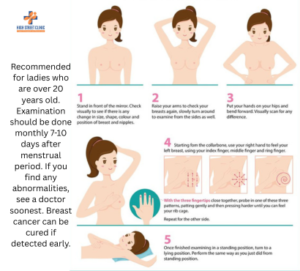1 | Importance of Breast Awareness
Breast cancer is the most common cancer among Indian women. Recognising changes early—like lumps, nipple retraction, skin dimpling—greatly improves outcomes. Around 40–70% of detected lumps are first noticed by women themselves.
2 | Self‑Awareness vs. Formal Self‑Exam
Major guidelines no longer recommend routine structured self-exams due to lack of mortality benefit and increased false positives. Instead, breast awareness—understanding your normal breast look and feel—is encouraged .
3 | How to Be Breast‑Aware
- Check at least twice a week
- Monthly check-ins, preferably after menstruation or a fixed day for post-menopausal women.
- Mirror inspection with arms at sides, on hips, and lifted—look for asymmetry, puckering, redness, or nipple changes.
- Physical feel: lying and standing positions, use circular motions, cover entire breast and armpit using differing pressures.
4 | Signs to Watch
- New lump or thickness in breast/underarm
- Skin changes: dimples, puckering, rash
- Nipple inversion or discharge (blood-stained)
- Persistent pain or localized swelling
- Skin texture resembling orange peel
Any persistent or concerning change requires prompt evaluation.
5 | Mammogram Screening Guidelines
- Start at age 40–45 for average-risk women; continue every 1–2 years
- High‑risk women (family history/genetic factors): start earlier + use ultrasound/MRI.
- Dense breast tissue may require supplemental imaging
6 | What Happens During Mammography
- Each breast is compressed between plates while X-rays are taken—takes ~10 minutes .
- Mild discomfort is common; discomfort subsides quickly.
- Uses low radiation; repeat screenings improve early detection and reduce mortality
7 | After the Mammogram
- Results typically within 1–2 weeks.
- If abnormal, follow-up may include targeted ultrasound, diagnostic mammogram, or biopsy.
- Regular scans help track changes over time.
8 | Breast Lumps: What to Know
- Most lumps are benign (cysts, fibroadenomas)—but thorough evaluation is essential.
- Characteristics that raise alarm: hard, irregular, fixed, growing lesions.
- Early assessment ensures peace of mind or early treatment as needed.

9 | Clinical Check-Ups
- For women 20+, annual clinical breast exams by a provider are recommended
- Clinical exams complement self-awareness and detect deeper abnormalities.
10 | Lifestyle Factors & Prevention
Support breast health by:
- Healthy weight & exercise
- Balanced diet: fiber, fruits, vegetables, limited alcohol
- Limiting alcohol & quitting smoking
- Hormone management
- Maintain breast familiarity and clinical check-ups
Empowering breast health starts with knowing your body, scheduling regular screenings, and responding promptly to changes. This approach supports early detection and peace of mind for women across India. A combination of breast awareness, clinical exams, and age‑appropriate mammography forms the foundation of proactive breast care.
FAQs
Q1. Should I practice self‑exams monthly?
Rather than formal monthly exams, focus on breast awareness—knowing how your breasts normally look and feel, and reporting any changes promptly
Q2. When should I start mammograms?
Begin discussing screening at age 40–45, with mammograms every 1–2 years for average-risk women. Those at higher risk should start earlier and may need additional imaging .
Q3. What if I feel a lump?
Stay calm. Schedule a clinical breast exam and imaging (ultrasound/mammogram). Early evaluation leads to early results—and if needed, early treatment.
